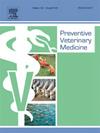评估猪生物安全网站作为教育和推广工具,并确定最终用户参与的最佳实践:一种学习分析方法
IF 2.2
2区 农林科学
Q1 VETERINARY SCIENCES
引用次数: 0
摘要
引进在商业和小规模养猪场实施生物安全措施是防止传染病传入和传播的一项持续努力。对养猪生产者进行有效的农场生物安全实践教育和培训势在必行。本研究旨在评估一个猪类生物安全网站作为推广工具,并通过跟踪和分析用户人口统计、参与和互动数据,确定最终用户参与的最佳实践。方法使用谷歌Analytics对某猪生物安全网站2022年7月5日至2023年12月31日的用户数据进行记录。RStudio软件和谷歌Analytics之间的直接交互促进了数据导出和用户人口统计和网站流量的分析。一个多变量负二项回归模型评估了网站事件计数(结果)和预测因子之间的关联,这些预测因子代表了用于访问网站的设备类型以及网站的发现方式。多变量线性回归模型评估了先前描述的预测变量与用户使用网站(结果)的持续时间之间的关联。每个州的用户数量和事件计数都在地图集中进行了说明,并且使用Local Moran's I方法来识别具有大量用户和事件计数的州,以评估网站在美利坚合众国(US)和全世界的外展。结果google Analytics报告了768个用户,聚合事件数为9643。用户来自78个国家,其中美国(708人)、菲律宾(202人)和加拿大(49人)的用户最多。该网站的用户分布在各个年龄段。下载最多的信息图表是“生物安全检查表”和“进入猪场的生物安全规程”。与手机和平板电脑相比,通过台式电脑访问网站的用户的网站参与度(总事件数和持续时间)明显更高,通过直接链接和搜索引擎访问网站的用户的参与度更高。在美国,在主要的养猪生产州,包括爱荷华州、明尼苏达州、伊利诺伊州、内布拉斯加州、印第安纳州和密苏里州,发现了当地高网站用户群。结论基于网络的猪生物安全学习环境可以为广大受众提供猪生物安全教育和资源。通过谷歌Analytics获得的网站流量数据有助于检查网站用户的行为模式、偏好和参与趋势,这些数据可用于未来增强网站。本研究所提出的网站追踪与分析方法,可应用于其他教育网站。本文章由计算机程序翻译,如有差异,请以英文原文为准。
Evaluating a swine biosecurity website as an education and outreach tool and identifying best practices for end-user engagement: A learning analytics approach
Introduction
Implementing biosecurity measures on commercial and small-scale swine farms is an ongoing effort to prevent the introduction and spread of infectious diseases. Educating and training swine producers on effective on-farm biosecurity practices is imperative. This study aims to assess a swine biosecurity website as an outreach tool and identify best practices for end-user engagement by tracking and analyzing data on user demographics, engagement, and interaction.
Methods
User data for a swine biosecurity website were recorded between 5th July 2022 and 31st December 2023 using Google Analytics. A direct interaction between RStudio software and Google Analytics facilitated data export and analysis on user demographics and website traffic. A multivariable negative binomial regression model assessed associations between website event counts (outcome) and predictors representing the type of devices used to access the website and how the website was found. A multivariable linear regression model evaluated associations between the previously described predictor variables and the duration for which the users engaged with the website (outcome). The number of users and event counts in each state was illustrated in choropleth maps, and the Local Moran's I method was used to identify states with a high number of users and event counts to evaluate the website’s outreach across the United States of America (US) and worldwide.
Results
Google Analytics reported 768 users with an aggregated event count of 9643. Users were from 78 countries, of which the most users were from the US (708), the Philippines (202), and Canada (49). The website users were distributed across all age categories. The "biosecurity checklist" and "biosecurity protocol of entering the swine farm" were the most downloaded infographics. The website engagement (total events and engagement duration) was significantly higher if users accessed the website on desktop computers compared to mobile phones and tablets, and was higher for users accessing the website through direct links, and search engines. In the US, local clusters of high website users were identified in leading swine production states, including Iowa, Minnesota, Illinois, Nebraska, Indiana, and Missouri.
Conclusion
The study findings support the utility of a web-based learning environment, which can provide swine biosecurity education and resources to a broad audience. The website traffic data obtained through Google Analytics helped examine the website users’ behavioral patterns, preferences, and engagement tendencies, which can be used to enhance the website in the future. The website tracking and analytical methods presented in this study can be applied to other educational websites.
求助全文
通过发布文献求助,成功后即可免费获取论文全文。
去求助
来源期刊

Preventive veterinary medicine
农林科学-兽医学
CiteScore
5.60
自引率
7.70%
发文量
184
审稿时长
3 months
期刊介绍:
Preventive Veterinary Medicine is one of the leading international resources for scientific reports on animal health programs and preventive veterinary medicine. The journal follows the guidelines for standardizing and strengthening the reporting of biomedical research which are available from the CONSORT, MOOSE, PRISMA, REFLECT, STARD, and STROBE statements. The journal focuses on:
Epidemiology of health events relevant to domestic and wild animals;
Economic impacts of epidemic and endemic animal and zoonotic diseases;
Latest methods and approaches in veterinary epidemiology;
Disease and infection control or eradication measures;
The "One Health" concept and the relationships between veterinary medicine, human health, animal-production systems, and the environment;
Development of new techniques in surveillance systems and diagnosis;
Evaluation and control of diseases in animal populations.
 求助内容:
求助内容: 应助结果提醒方式:
应助结果提醒方式:


